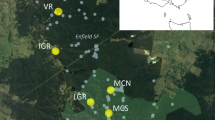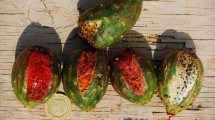Abstract
The relationship between heretozygosity and vegetative fitness was explored in the narrow endemic and threatened Clematis acerifolia (Ranunculaceae), both at individual and population levels. The relationships between fitness, habitat factors, and population size were also analyzed. Allozyme electrophoresis was used to quantify the levels of heterozygosity of nearly 200 surveyed individuals belonging to the nine extant populations of this species. Six parameters of vegetative fitness were measured: plant height, shrub diameter, length of the largest leaf, width of the largest leaf, mean number of leaves/stem, and total number of stems. The percentage of tree cover (light availability) was measured as an indicator of habitat quality. A principal component analysis reduced the original fitness variables to two uncorrelated principal components. None of these correlated significantly with both heterozygosity and population size, in contrast to the expected result. Nevertheless, one of the principal components showed a positive relationship with light availability, which may indicate that habitat quality may have significant effects on the performance of this species. Thus, to ensure the viability of this endangered species, maintenance of adequate habitat quality (by avoiding further fragmentation) may be more important than maximizing genetic diversity within populations.

Similar content being viewed by others
References
Allendorf FW, Leary RF (1986) Heterozygosity and fitness in natural populations of animals. In: Soulé M (ed) Conservation biology: the science of scarcity and diversity. Sinauer, Sunderland, pp 57–76
Boerrigter EJM (1995) On the perspectives of populations of the rare plant species Phyteuma nigra. Ph.D. Thesis, State University of Groningen, The Netherlands
Booy G, Hendriks RJJ, Smulders MJM, van Groenendael JM, Vosman B (2000) Genetic diversity and the survival of populations. Plant Biol 2:379–395
Bosch M, Waser NM (1999) Effects of local density on pollination and reproduction in Delphinium nuttallianum and Aconitum columbianum (Ranunculaceae). Am J Bot 86:871–879
Britten H B (1996) Meta-analyses of the association between multilocus heterozygosity and fitness. Evolution 50:2158–2164
Buza L, Young A, Thrall P (2000) Genetic erosion, inbreeding and reduced fitness in fragmented populations of the endangered tetraploid pea Swainsona recta. Biol Conserv 93:177–186
Campbell DR, Halama JJ (1993) Resource and pollen limitations to lifetime seed production in a natural plant population. Ecology 74:1043–1051
Clayton JW, Tretiak DN (1972) Amino-citrate buffers for pH control in starch gel electrophoresis. J Fish Res Board Can 29:1169–1172
Ellstrand NC, Elam DR (1993) Population genetic consequences of small population size: Implications for plant conservation. Annu Rev Ecol Syst 24:217–242
Fennema F (1990) Effects of exposure to atmospheric SO2, NH3 and (NH4)2SO4 on survival and extinction of Arnica montana L. and Viola canina L, Report Research Institute for Nature Management 90/14, Arnhem, The Netherlands
Fischer M, Matthies D (1997) Mating structure and inbreeding and outbreeding depression in the rare plant Gentianella germanica (Gentianaceae). Am J Bot 84:1685–1692
Frankham R (1996) Relationships of genetic variation to population size in wildlife. Conserv Biol 10:1500–1508
Frankham R (2005) Genetics and extinction. Biol Conserv 126:131–140
Gaston KJ, Blackburn TM, Greenwood JJD, Gregory RD, Quinn RM, Lawton JH (2000) Abundance-occupancy relationships. J Appl Ecol 37:39–59
Gong WZ, Long YY, Li MX (1985) Karyotype studies on Clematis from Beijing, China. J Wuhan Bot Res 3:371–379
Hansson B, Westerberg L (2002) On the correlation between heterozygosity and fitness in natural populations. Mol Ecol 11:2467–2474
Hensen I, Oberprieler C, Wesche K (2005) Genetic structure, population size, and seed production of Pulsatilla vulgaris Mill. (Ranunculaceae) in Central Germany. Flora 200:3–14
IUCN (2001) IUCN Red List Categories and Criteria: Version 3.1, UCN Species Survival Commission, Gland and Cambridge
Kéry M, Matthies D, Spillmann H-H (2000) Reduced fecundity and offspring performance in small populations of the declining grassland plants Primula veris and Gentiana lutea. J Ecol 88:17–30
Kimura M (1983) The neutral theory of molecular evolution. Cambridge University Press, Cambridge
Knowles P, Mitton JB (1980) Genetic heterozygosity and radial growth variability in Pinus contorta. Silvae Genet 29:114–118
Lammi A, Siikamäki P, Mustajärvi K (1999) Genetic diversity, population size, and fitness in central and peripheral populations of a rare plant Lychnis viscaria. Conserv Biol 13:1069–1078
Lienert J, Fischer M, Schneller J, Diemer M (2002) Isozyme variability of the wetland specialist Swertia perennis (Gentianaceae) in relation to habitat size, isolation, and plant fitness. Am J Bot 89:801–811
Linhart Y, Mitton JB (1985) Relationships among reproduction, growth rates, and protein heterozygosity in ponderosa pine. Am J Bot 72:181–184
López-Pujol J, Zhang F-M, Ge S (2005) Population genetics and conservation of the critically endangered Clematis acerifolia (Ranunculaceae). Can J Bot 83:1248–1256
Luijten SH, Dierick A, Oostermeijer JGB, Raijmann LEL, den Nijs HCM (2000) Population size, genetic variation, and reproductive success in a rapidly declining, self-incompatible perennial (Arnica montana) in The Netherlands. Conserv Biol 14:1776–1787
Mitton JB (1989) Physiological and demographic variation associated with allozyme variation. In: Soltis DE, Soltis PS (eds) Isozymes in plant biology. Dioscorides Press, Portland, pp 127–145
Mitton JB (1994) Molecular approaches to population biology. Annu Rev Ecol Syst 25:45–69
Mitton JB, Grant MC (1984) Associations among protein heterozygosity, growth rate, and developmental homeostasis. Annu Rev Ecol Syst 15:479–499
Nei M (1987) Molecular evolutionary genetics. Columbia University Press, New York
Noel F, Machon N, Porcher E (2007) No genetic diversity at molecular markers and strong phenotypic plasticity in populations of Ranunculus nodiflorus, an endangered plant species in France. Ann Bot 99:1203–1212
Ohta R (1971) Associative overdominance caused by linked detrimental mutations. Genet Res 18:277–286
Oostermeijer JGB, van Eijck MW, den Nijs JCM (1994) Offspring fitness in relation to population size and genetic variation in the rare perennial plant species Gentiana pneumonanthe (Gentianaceae). Oecologia 97:289–296
Oostermeijer JGB, Luijten SH, Krenová ZV, den Nijs JCM (1998) Relationships between population and habitat characteristics and reproduction of the rare Gentiana pneumonanthe L. Conserv Biol 12:1042–1053
Oostermeijer JGB, Luijten SH, den Nijs JCM (2003) Integrating demographic and genetic approaches in plant conservation. Biol Conserv 113:389–398
Orellana MR, López-Pujol J, Blanché C, Bosch M (2007) Relationships between heterozygosity and fitness in the Iberian threatened larkspur Delphinium bolosii (Ranunculaceae). Flora 202:161–168
Paschke M, Abs C, Schmid B (2002) Relationship between population size, allozyme variation, and plant performance in the narrow endemic Cochlearia bavarica. Conserv Genet 3:131–144
Reed DH, Frankham R (2003) Correlation between fitness and genetic diversity. Conserv Biol 17:230–237
Savolainen O, Hedrick P (1995) Heterozygosity and fitness: no association in scots pine. Genetics 140:755–766
Soltis DE, Haufler H, Darrow D, Gastony J (1983) Starch gel electrophoresis of ferns: a compilation of grinding buffers, gel and electrode buffers and staining schedules. Am Fern J 73:9–27
Spielman D, Brook BW, Frankham R (2004) Most species are not driven to extinction before genetic factors impact them. Proc Natl Acad Sci USA 101:15261–15264
Thelen GC, Allendorf FW (2001) Heterozygosity-fitness correlations in rainbow trout: effects of allozyme loci or associative overdominance? Evolution 55:1180–1187
Vergeer P, Rengelink R, Copal A, Ouborg NJ (2003) The interacting effects of genetic variation, habitat quality and population size on performance of Succisa pratensis. J Ecol 91:18–26
Wang W-T (2002) A revision of Clematis sect. Cheiropsis (Ranunculaceae). Acta Phytotaxon Sin 40:193–241
Wendel F, Weeden NF (1989) Visualization and interpretation of plant isozymes. In: Soltis DE, Soltis PS (eds) Isozymes in plant biology. Dioscorides Press, Portland, pp 5–45
Yang Q-E (2002) Cytology of ten species in Anemone, one in Anemoclema and six in Clematis (Trib. Anemoneae, Ranunculaceae) from China. Acta Phytotaxon Sin 40:396–405
Young A, Boyle T, Brown T (1996) The population genetic consequences of habitat fragmentation for plants. Trends Ecol Evol 11:413–418
Zouros E, Foltz DW (1987) The use of allelic isozyme variation for the study of heterosis. In: Rattazzi MC, Scandalios JG, Whitt GS (eds) Isozymes: current topics in biological and medical research, vol 13, Alan R. Liss Publisher, New York, pp 1–59
Acknowledgments
The authors thank Jing-Hua Shi and Ding Wu for their assistance in the field work, A-Man Zhao and Guo-Qin Yu for their help in experimental work, and Prof. Wen-Tsai Wang for his valuable comments. We also thank the Chinese Academy of Sciences (KSCX2-SW-106, KSCXZ-SW-101A) for financial support. This work was also subsidized by two grants from the Spanish Ministry of Education and Science to the first author, one for a predoctoral stay of two months at the Beijing Institute of Botany (2003) and the other (EX2005-0922) for two years of postdoctoral research (2006–2007) at the same institution.
Author information
Authors and Affiliations
Corresponding author
Rights and permissions
About this article
Cite this article
López-Pujol, J., Zhang, FM. & Ge, S. No Correlation Between Heterozygosity and Vegetative Fitness in the Narrow Endemic and Critically Endangered Clematis acerifolia (Ranunculaceae). Biochem Genet 46, 433–445 (2008). https://doi.org/10.1007/s10528-008-9161-y
Received:
Accepted:
Published:
Issue Date:
DOI: https://doi.org/10.1007/s10528-008-9161-y




